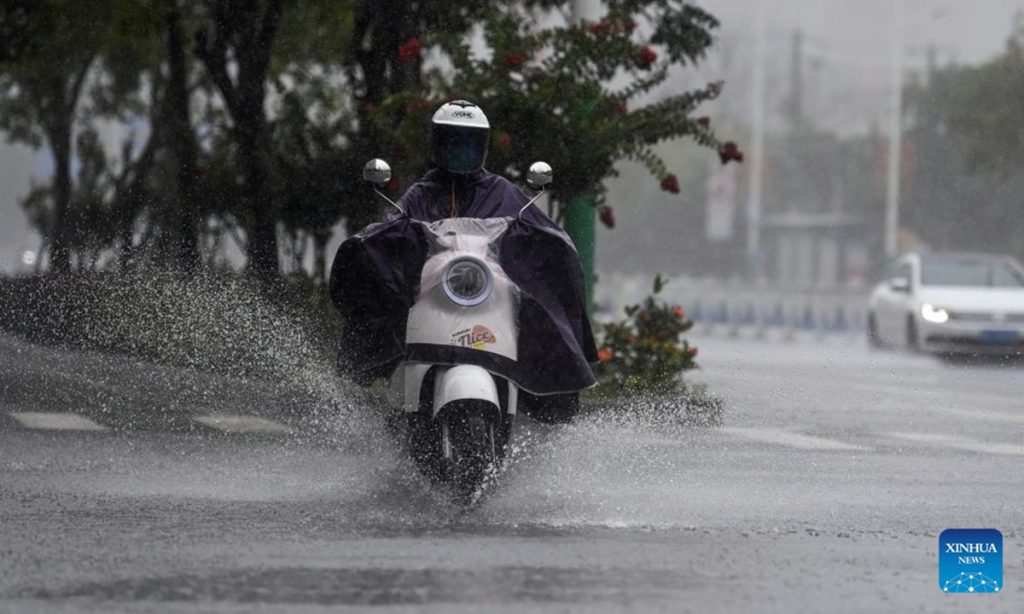Chinese meteorological authorities warn of heat waves in north and floods in south

China's National Meteorological Center (NMC) issued yellow heat alerts on Monday for most of northern China, warning of temperatures exceeding 35 C — with certain regions and cities surpassing 40 C. Meanwhile, eight southern provinces are expected to experience torrential downpours and flood risks in certain area.
The NMC renewed a yellow alert at 6 am on Monday, warning of high temperatures in multiple regions of the country.
The center forecast scorching conditions exceeding 35 C on Monday across vast areas including most of Beijing, Tianjin, North China's Hebei Province and the Inner Mongolia Autonomous Region, East China's Shandong Province, Central China's Henan Province, Fenwei Plain, Northeast China's Liaoning and Jilin provinces, as well as the Junggar Basin of Northwest China's Xinjiang Uygur Autonomous Region and the southern Xinjiang Basin.
Particularly intense heat of 37 - 39 C is expected in some of the aforementioned regions - while some areas may exceed 40 C, the NMC said.
The center advised people to take protective measures to prevent prolonged outdoor exposure during peak heat hours.
Education authorities in Beijing issued heat advisories on Monday, urging kindergartens, primary and secondary schools and vocational institutes to suspend outdoor activities during peak heat hours.
China experienced eight large-scale heatwaves in 2024, with the number of high-temperature days during the summer reaching the second-highest number since 1961, according to the China Meteorological Administration (CMA). Nearly half of the provinces in China recorded their highest average temperatures since national meteorological records began, the CMA said.
Regarding 2025's scorching heat, Ma Jun, director of the Beijing-based Institute of Public and Environmental Affairs, told the Global Times on Monday that the potential onset of a La Nina event is expected to slightly temper the sweltering weather. However, Ma noted that the fundamental trend of global warming remains unchanged, urging continued vigilance against extreme weather events.
At the same time, southern China faces a starkly different weather pattern.
The NMC raised a blue alert for heavy rainfall at 6 am Monday, warning of substantial downpours from 8 am Monday to 8 am on Tuesday in several regions.
Rain-affected areas include East China's Zhejiang and Jiangxi provinces, Central China's Hunan Province, Southwest China's Guizhou and Yunnan provinces, South China's Guangxi Zhuang Autonomous Region, western parts of the Sichuan Basin, and Southwest China's Xizang Autonomous Region, the NMC said.
Besides, some southeastern parts of Guizhou may see hourly rainfall of 100 to 120 millimeters, the center said.
Certain regions may experience short-term heavy rain of 20 to 50 millimeters hourly, even exceeding 60 millimeters, accompanied by thunderstorms and gales, according to the NMC.
The Ministry of Water Resources said that torrential rains have triggered flooding in 27 rivers exceeding warning levels across Guangxi, Guizhou and Yunnan between 8 am Saturday and 8 am Sunday. Some rivers exceeded thresholds by up to 3.71 meters, CCTV News reported Monday.
The Mengtong River in Yunnan experienced its worst flooding since 1979, according to CCTV News.
Last week, flash floods hit Huaiji county, South China's Guangdong Province. By noon on June 18, all 19 townships in the county had sustained damage, affecting around 300,000 residents, the Xinhua News Agency reported.
Local authorities evacuated nearly 70,000 people as floodwaters surged. The disaster left 15 injured, though none serious, the report added.
Ma noted that Typhoon Wutip has brought heavy rainfall to southern regions, with extreme precipitation concentrated in mountainous areas. This has triggered mountain floods and debris flows, posing serious threats to the lives and property of local residents.
The MWR maintains a Level-IV flood emergency response in Zhejiang, Anhui, Central China's Hubei and Hunan provinces, Guangxi and Guizhou, deploying three task forces to assist flood control efforts in Hubei, Hunan and Guangxi.
Meanwhile, the Ministry of Natural Resources activated geological disaster emergency responses in Hunan, Hubei, Southwest China's Chongqing Municipality, Guizhou, and Henan amid persistent rainfall nationwide, dispatching professional teams to oversee disaster prevention.
In Hunan, the National Food and Strategic Reserves Administration urgently deployed 81,500 relief items — including tents, folding beds, and summer quilts — to support emergency relocation and basic needs, CCTV News reported.
Ma, the expert, added that the summer grain harvest in the hardest-hit townships may be affected, though the overall impact on the national summer grain yield remains limited. Residents in severely affected areas are advised to expedite drainage of flooded farmland to reduce soil waterlogging once normal life is resumed. For fields with total crop failure, farmers should replant or switch to alternative crops based on local conditions.